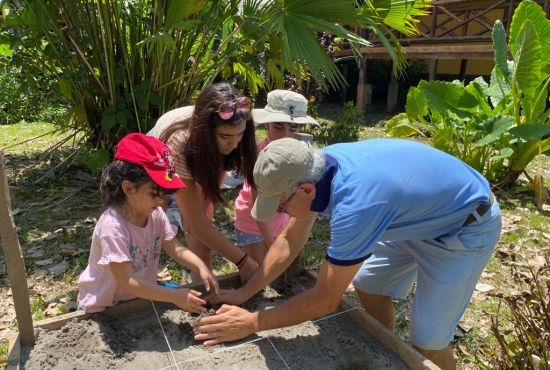
The release of the Taricaya turtles takes place at the end of October and the first half of November as part of the repopulation of this endangered species, a successful conservation program of the Municipality of Naynas and that takes place every year. .
Do you want to be part of this wonderful experience?
First experience: sowing the eggs
It occurs the last week of August, when hundreds of taricaya turtle eggs are "sown". At Heliconia Lodge it is planted on an artificial beach located in the Lodge's gardens.
Second experience: Birth of the taricayas
It takes place between the third and fourth week of October, not only will you be able to see the birth of the taricayas but you will also actively participate helping them get out of the sand and place them in buckets with water. DON'T MISS ANYONE!!! they are very fast.
We do not know the exact date of the birth of the taricayas but what we do know is that a group of lucky guests will witness the miracle of life and an experience with nature that they will never forget.
Third experience: The liberation of the turtles
This activity is the most extraordinary of the turtle release process, it takes place during the first fortnight of November and consists of releasing them in their natural habitat and guests can actively participate by releasing a turtle in the Amazon River ravines.
In this third experience you are guaranteed a unique conservation experience.
The Taricaya
The Taricaya, scientifically known as Podocnemis unifilis, is a medium-sized aquatic turtle; the females are larger than the male (33 to 48 centimeters and the weight is 5 to 12 kilos). The male is known as "capitaris" and differs from females by having yellowish spots on the head when they are adults. They reach adulthood (that is, they begin to lay eggs) at 5 or 6 years of age. They reproduce in the dry season (between the months of July and August) when natural beaches appear, where they lay and incubate an average of 34 eggs per clutch. The diet is a frugivorous diet, it behaves like an omnivore.
The main threat to the conservation of the "taricaya" is the illegal collection of its eggs by man. Likewise, the nests are attacked by ants, hawks, buzzards, black iguana and ocelot. The young are also eaten by the black iguana, lizards and some fish such as tucunaré, arahuana and paiche.
LET'S KNOW MORE ABOUT THE TARICAYA
It is a species with a distribution range in almost the entire lowland forest region, in the departments of Loreto, and has been used since time immemorial by different indigenous groups as a source of protein and has played an important role within their cultures. Taricaya exploitation in Loreto dates back many decades, to the point of leaving its populations in critical condition. This resource is an important part of the diet of the riverside dweller, because its eggs and meat are foods rich in protein and oil. Due to repopulation efforts, the taricaya is currently abundant in places where management programs have been implemented.
Morphology
The taricaya has a convex (arched) and oval-shaped shell, with only a slight widening towards the back; it has a slightly prominent dorsal crest, but evident on the central shields 2 and 3. On the forehead there is a groove, which extends from the nose to between the eyes, and on the chin it bears a central barbule, or occasionally 2 barbules arranged very together.
The carapace is blackish in color and the breastplate varies - from blackish to pale yellow. The head of the adult female is brown or rust brown above and the jaws are pale yellowish. The head of the males is basically dark gray, with some yellow spots. The neck, legs and tail are grey.
The male differs from the female in that: 1) it is smaller in size; 2) has a more developed tail, particularly from the base to the anus; 3) the anal notch of the breastplate is wider; 4) the head has yellow spots; and 5) the iris of the eye is greenish (in females it is blackish). These differences are not observed in hatchlings and juveniles.
The newly hatched hatchlings measure 34 to 44 centimeters in carapace length and weigh between 9 and 20 grams.
Behaviour
They are quite playful, skilled swimmers and a bit shy when they are small. In the morning they prefer to sunbathe, the shell becomes very soft from being in the water for so long, and it could break easily. Despite being semi-aquatic, they prefer to thrive in water than on land. When they are threatened they tend to bite, and the bite is quite strong.
Feeding
The taricaya is a species with a frugivorous and herbivorous diet, but in some cases it behaves as an omnivore; however, their diet is mainly based on aquatic plants such as huama, duckweed and fruits of riverside plants. Fittingly, it also feeds on shellfish, fish, and dead animals.
Reproduction
The females spawn twice a year and in each spawning they lay between 20 and 46 eggs, but occasionally up to 52. Spawning occurs during the annual low water of the rivers, which extends from June to September or October in the Marañón, Ucayali, Amazonas and its tributaries. It spawns many times also on the chalky banks of rivers, pipes and oxbow lakes. To spawn, they dig a hole in the sand with their hind legs, about 15 to 20 centimeters deep, where they deposit the eggs and then cover it up again. For this species this process takes from half an hour to an hour.